МИНИСТЕРСТВО ОБРАЗОВАНИЯ И НАУКИ
ДОНЕЦКОЙ НАРОДНОЙ РЕСПУБЛИКИ
ГОСУДАРСТВЕННОЕ БЮДЖЕТНОЕ ПРОФЕССИОНАЛЬНОЕ
ОБРАЗОВАТЕЛЬНОЕ УЧРЕЖДЕНИЕ
«ГОРЛОВСКИЙ ТЕХНИКУМ ДИЗАЙНА И СФЕРЫ УСЛУГ»
Методическая разработка урока
по учебной дисциплине Иностранный язык
по теме:
«Путешествия. Чудеса и загадки природы»
подготовила
преподаватель английского языка
Юркова Д.Ю.
Горловка
2024
Дата:
Группа №
Курс
Тема Путешествия
Тема урока Чудеса и загадки природы
Цели:
- практическая:
-
актуализация опорных знаний и умений по изучаемой теме;
-
совершенствование навыков аудирования;
-
совершенствование навыков чтения с частичным и полным пониманием прочитанного;
-
совершенствование навыков устной речи;
- образовательная/познавательная: расширение филологического, страноведческого и общекультурного кругозора студентов, углубление знаний лексики по теме «Путешествия»;
- развивающая: развитие языковой догадки и речевой реакции, слуховой, зрительной, ассоциативной памяти, кратковременной и долговременной памяти, логического и аналитического мышления;
- воспитательная: развитие любознательности, интереса к приобретению знаний, воспитание любви к иностранному языку, иностранной речи; формирование деловой активности, самостоятельности, ответственности, воспитание усидчивости, внимательности, трудолюбия.
Тип урока: урок совершенствования речевых навыков
Вид урока: смешанный
Оснащение урока, средства обучения:
-
учебник: Афанасьева О. В. Английскийязык. 11класс. Учеб. для общеобразоват. организаций. Базовыйуровень. (Английский в фокусе) / О. В. Афанасьева, Д. Дули, И. В.Михеева и др. – М.: Просвещение, 2016;
-
раздаточные материалы;
-
проектор, ноутбук;
-
видео:
-
The 7 Wonders of the Modern World - 2017.mp4
-
The New 7 Wonders of the World.mp4
-
Top 10 beautiful Natural Wonders of the World 2017.mp4
-
What A Wonderful World With David Attenborough -- BBC One [FULL HD].mp4
-
Wonders of the world.mp4
Ход урока
-
Начало урока
1.1. Организационный момент:
а) приветствие/Greeting:
Teacher (T): - Good morning, dear students! It’s so nice to see you!
Students (Sts): - Good morning, dear teacher! It’s so nice to see you, too!
Преподаватель и студенты приветствуют друг друга.
б) проверка готовности к уроку, проверка присутствия:
T: - I hope that you are ready for the lesson. Tell me, please, who is absent today in your group?
St1: - ..., ..., ... are absent today in our group.
Преподаватель отмечает отсутствующих.
в) сообщение темы и задач урока/ Aim:
T: - We continue our topic: module Travel. Today we are going to speak not only about our tastes in travelling, about different countries, but also about various places, even mystic places around the world! The thing is that the topic of our lesson today is “Wonders and mysteries of nature”. Today we’ll practice our listening, reading and speaking skills.
Преподаватель сообщает, что изучаемая тема «Путешествия» продолжается и на сегодняшнем уроке. Основная цель сегодня – практикуя навыки аудирования, чтения и устной речи, узнать много нового о странах мира, о загадочны и таинственных местах нашей планеты.
T: - Open your notes and put down the date of today, class-work and the topic of our lesson.
Студенты записывают число, вид работы и тему урока в своих тетрадях.
г) Проверка домашнего задания
T: - Let’s check your homework – so let’s start with the quiz as for the topic “English-speaking countries”! Are you ready? Let’s go!
Домашним заданием была подготовка к страноведческому опросу по изученным темам, касающимся англоговорящих стран. Таким образом, проверка домашнего задания представляет собой фронтальный опрос по страноведению. Каждый студент зарабатывает баллы за каждый правильный ответ. (ПРИЛОЖЕНИЕ 1)
-
Введение в иноязычную атмосферу/ Warmingup:
(совершенствование навыков аудирования)
T: - Listen to the article and complete the table.
Студенты слушают текст статьи о путешествиях и заполняют таблицу, в которой пропущена некоторая информация. (ПРИЛОЖЕНИЯ 2 и 3)
T: - Now let’s check your answers. Please, read what you have written in the columns of your tables.
Студенты зачитывают заполненные колонки таблиц:
|
| When to visit | What to see / do |
| Australia | December | Sydney outdoor life water sports |
| South Africa | February | Exotic animals; wonderful coastline – to swim |
| India | January | Colours, views and monuments; exciting markets |
| Canada | November | Mountains and beautiful lakes |
| Ireland | March | St Patrick’s festivities; fantastic countryside |
T: - Thank you very much, dear students! Good of you!
-
Основная часть урока
2.1. Актуализация опорных знаний и умений по изучаемой теме. Совершенствование навыков аудирования
Организация прослушивания студентами текста
Pre-Listening Activity / Предварительные задания перед прослушиванием текста
T: - Well, and now I’d like to show you rather interesting video about mysteries and wonders of our planet. I’d like to watch it and enjoy it together with you, if you don’t mind!
Просмотр видео «Чудеса древнего мира»
T: - Can you comment on what you’ve just watched? Express your emotions.
Преподаватель просить студентов прокомментировать, что они сейчас видели, и выразить свои эмоции по поводу увиденного.
T: - Before we start reading the texts or speaking as for our today’s topic, I want you to listen to the song which is untitled as “Mysteries”. But first, let’s see the task at page SS4 of your textbooks. So, read the words and phrases below and tell me in what context do you expect to find them.
Студенты знакомятся с заданием в учебнике: читают фразы и говорят, в каком контексте, они полагают, встретятся данные фразы в песне.
Listening / Прослушивание студентами песни“Mysteries”:
T: - Be very attentive to be successful while doing the task.
(ПРИЛОЖЕНИЕ 4)
Post-ListeningActivity / Выполнение студентами заданий на понимание услышанного:
T: - Dear students, now, please, answer the questions: How do ancient places make the singer feel?
-
Imagine you could travel back in time. Where would you go? Why? Give reasons.
-
Let’s discuss the following proverbs. What do they mean to you? How do you understand such words? Explain it to us:
-
Wonders will never cease.
-
Truthisstrangerthanfiction.
-
Студенты, прослушав песню, отвечают на поставленные преподавателем вопросы по ее содержанию, обговаривают значение предложенных высказываний по теме (упражнения 2, 3,4 страница SS 4).
T: - Thank you very much for your opinions!
2.2. Совершенствование навыков чтения
Организация чтения текста
Pre-ReadingActivity / Предварительные задания – подготовка к прочтению текста (упражнение 1 стр. 138)
T: - Now, open your textbooks and look at the pictures at pages 138 – 139, please. Tell me, what do you know about these places? What do you think makes them mysterious and why?
Students’ answers.
Студенты рассматривают картинки к тексту в учебнике и сообщают известные им сведения об указанных «загадочных» местах.
Прослушивание студентами текста «Таинственные места»
(страницы 138 - 139)
T: - Now, let’s listen to record of the text.
Студенты прослушивают запись текста.
Reading / Чтение студентам текста
T: - Now I want you, dear students, to read the text yourself and find out the necessary information.
Студенты читают текст «про себя» и находят необходимую информацию для выполнения дальнейших упражнений.
Post-Reading Activity / Послетекстовые задания (упражнения 2, 3, 4):
T: - Now, please, answer the questions:
Which place (A, B, C or D) …
-
cannot be easily seen?
-
isinthemiddleofanocean?
-
took about 150 years to create?
-
was discovered by an American?
-
includes a stadium?
-
is at the base of a mountain?
-
was built for religious reasons?
-
has decorations below ground level?, etc. (exercise 2, page 138)
Студенты отвечают на вопросы преподавателя, используя информацию из текста.
T: - Now match the underlined words to their meaning.
Студенты соотносят подчеркнутые в тексте слова с их значениями, данными в упражнении 3, стр. 138.
T: - Dear students, now make up sentences to answer the following questions: How are the following related to each place?
-
Job Roggeveen
-
Lord Shiva
-
Spanish invaders
-
the Oracle
-
Hiram Bingham
-
the Pythia
-
monks
Студенты составляют предложения, используя полученную при прочтении текста информацию - упражнение 4, стр. 138.
-
Совершенствование навыков письменной речи
Письменная индивидуальная работа в тетрадях (упражнение 6 стр. 139)
T: - Now, students, I want you to do some individual work. I mean do exercise 6 at page 139 in a written form. Then I’ll check your notes.
Студенты выбирают и выписывают подходящее по смыслу слово из двух предложенных в каждом предложении, а затем составляют предложения с неиспользованными словами. Затем преподаватель выборочно берет тетради на проверку.
-
Совершенствование навыков устной речи
Интерактивные задания – работа в группах
T: - Now, join into groups and decide what the text is about: unite parts of the text to get full information.
Студенты, объединившись в группы, получают карточки с дополнительной информацией о загадках, тайнах, чудесах природы. Им необходимо соединить части текстов и догадаться, о каком чуде природы идет речь (ПРИЛОЖЕНИЯ 5 и 6)
T: - Please, show your answers, your results and say a few words about “your” wonders (just give a short summary).
Студенты представляют свои ответы, поясняя, какой результат у них получился и кратко рассказывают о «своем» (отгаданном) чуде современного мира. Им предоставляется ответ-картинка правильно отгаданного «чуда».
T: - Thank you for your work! So again let’s watch an interesting video about modern wonders of the world!
Просмотр видео «Современные 7 чудес света»
T: - Now work in pairs: tell your partner, which place would you like to visit and why?
Студенты работают в парах: рассуждают, какое из «загадочных» мест они бы хотели посетить и объясняют, почему.
T: - Please, comment on the following statement: “Without mysteries, life would be very dull indeed. What would be left to strive for if everything were known?”
Далее происходит общее комментирование высказывания о загадках и тайнах природы кельтского народного музыканта Чарльза де Линта:«Без загадок жизнь была бы поистине скучна. За что оставалось бы бороться, если бы все уже было известно?» (упражнение 7 стр. 139 и комментирование высказывания в рубрике «Слова мудрости»)
T: - Thank you so much, dear students, for your thoughts as for these words of wisdom.
III. Заключительная часть урока
3.1. Сообщение и пояснение домашнего задания/ Homework:
T: - Your home assignment is exercise 1 at page 178: you should read and translate the text “Bermuda Triangle” and choose the correct answer.
3.2.Подведение итогов урока (выставление оценок, рефлексия) / Summarizing:
Беседа в режиме – Т – St1 – St2 – St3
Т: - What have we spoken about at the lesson today? What was our topic?
-
Do you like our today’s lesson? Why?
-
What new phrases have you learnt during the lesson? Name them?
-
Was the information interesting/ difficult/ familiar to you?
-
Describe / Express in one word you feelings as for this lesson.
T: - Thanks a lot for your active work at our lesson. As for the marks: … gets “5”, … gets “4”, etc.
T: - Before the bell rings, I want you to see some video for us – people – not to forget how beautiful the planet Earth is and that indeed nature always gives us lots of incredible wonders and mysteries!
Просмотр видео “What a wonderful world”
T: - Good-bye, dear students! See you next lesson!
ПРИЛОЖЕНИЕ 1
Страноведческий опросник
THE UNITED KINGDOM OF GREAT BRITAIN
AND NORTHERN IRELAND
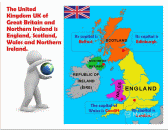
1. Where is the United Kingdom situated?
2. What is the area of the United Kingdom?
3. What countries does it consist of?
4. What is the highest mountain on the British Isles?
 5. What is the longest river?
5. What is the longest river?
6. What is the highest mountain in Wales?
7. What is the northern part of Scotland called?
8. What is the population of the United Kingdom?
 9. How many people live in London?
9. How many people live in London?
10. What industry is developed in South Wales?
11. What kind of state is the United Kingdom?
12. What houses does the British parliament consist of?
13. What are the main political parties?
14. Who chooses the Cabinet of Ministers?
15. What is the flag of the United Kingdom called?
THE UNITED STATES OF AMERICA
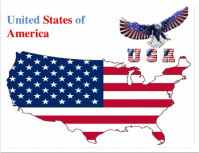 1. Where is the USA situated?
1. Where is the USA situated?
2. What area has the USA?
3. What mountains are there in the country?
4. What is situated between the Cordilleras and the Appalachian mountains?
5. What are the main rivers?
6. What kind of climate is there in the USA?
7. What is the population of the USA?
8. How many states are there in the USA?
9. What kind of state is the USA?
10. Who is the head of the state?
11. What is the capital of the USA?
 12. What are the main parties?
12. What are the main parties?
13. What is the financial & business centre of the country?
14. When is Thanksgiving Day celebrated?
15. When is Independence Day celebrated?
CANADA
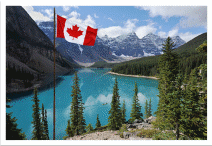 1. What is the capital of Canada?
1. What is the capital of Canada?
2. What is the area of Canada?
3. Where is Canada situated?
4. What is Canada rich in?
5. What is the population of Canada?
6. What are the most important cities?
7. What are Canada’s largest ports?
8. What are the largest lakes in Canada?
9. What mountains are there in Canada?
10. What are the longest rivers?
11. What is the largest island in the north of Canada?
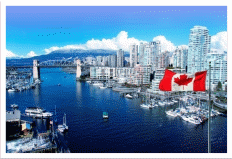 12. What kind of state is Canada?
12. What kind of state is Canada?
13. How many provinces and territories does it consist of?
14. What houses does the Federal Parliament consist of?
15. What are Canada’s main agricultural products?
THE COMMONWEALTH OF AUSTRALIA
 1. What is the official name of Australia?
1. What is the official name of Australia?
2. What territories are there in the Commonwealth of Australia?
3. What area has Australia?
4. What is the capital of Australia?
5. In what hemisphere is Australia situated?
6. What is the population of Australia?
7. What are the biggest cities in Australia?
8. What is the main occupation in Australia?
9. What agricultural product is Australia famous for?
10. What are the longest rivers?
11. What mountains are there in Australia?
 12. What does Australia consist of?
12. What does Australia consist of?
13. What houses does the Federal Parliament consist of ?
14. Who is formally the head of the state?
15. Who represents the Queen of England?
NEW ZEALAND
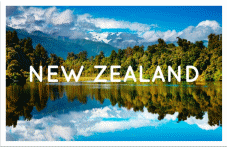
1. Where is New Zealand situated?
2. What islands does it consist of?
3. On which island are there many lakes?
4. What sea washes the western coast of New Zealand?
5. What is the highest mountainous range?
6. What is the national emblem of New Zealand?
7. What is the capital?
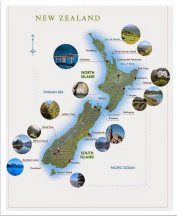 8. What are the main cities?
8. What are the main cities?
9. What is the nickname of New Zealand?
10. Which city resembles Edinburgh?
11. What is the population of New Zealand?
12. Who are the Maoris?
13. What are they famous for?
14. What houses does the Parliament consist of?
15. Who represents the Queen of England?
Ключи / KEYS
THE UNITED KINGDOM OF GREAT BRITAIN AND NORTHERN IRELAND
1. On the British Isles.
2. Over 244,000 square kilometres.
3. England, Scotland, Wales and Northern Ireland.
4. Ben Nevis.
5. The Severn.
6. Snowdon.
7. Highlands.
8. Over 57 million people.
9. More than 9 million.
10. Coal-mining.
11. Constitutional monarchy.
12. The House of Lords and the House of Commons.
13. The Conservative and Labour Parties.
14. The Prime Minister.
15. The Union Jack.
THE UNITED STATES OF AMERICA
1. In the central part of the North American Continent.
2. Over nine million square kilometres.
3. The Cordillera, the Rocky Mountains, the Appalachian.
4. The prairie and the Mississippi valley.
5. The Mississippi, the Colorado, the Columbia.
6. Several different climatic regions.
7. More than 236 million people.
8. Fifty states.
9. A federal republic.
10. The president.
11. Washington, D.C.
12. The Democratic and Republican Parties.
13. New York.
14. The fourth Thursday in November.
15. The fourth of July.
CANADA
1. Ottawa.
2. Nearly 10 million square kilometres.
3. In the northern part of the North American continent.
4. Metal ores, oil and gas.
5. Over 24 million people.
6. Montreal, Toronto, Edmonton, Hamilton, Winnipeg, Quebec.
7. Vancouver, Montreal, Halifax.
8. The Great Lakes Superior, Huron, Erie and Ontario, Great Bear Lake, Great Slave Lake and Lake Winnipeg.
9. The Rocky Mountains.
10. The Mackenzie, Yukon, St. Lawrence River.
11. Baffin Island.
12. A federal state and a member of the Commonwealth.
13. Ten provinces and two territories.
14. The Senate and the House of Commons.
15. Wheat, meat, some kinds of fruit and dairy products.
THE COMMONWEALTH OF AUSTRALIA
1. The Commonwealth of Australia.
2. The Continent of Australia, the island of Tasmania and a number of smaller islands.
3. About 8 million square kilometres.
4. Canberra.
5. The South hemisphere.
6. About 15 million people.
7. Sydney, Melbourne, Adelaide, Perth, Brisbane.
8. Agriculture.
9. Sheep.
10. The Murray and the Darling.
11. The Australian Alps, the Blue Mountains.
12. Six states and two territories.
13. The Senate and the House of Representatives.
14. The Queen of England.
15. The governor-general.
NEW ZEALAND
1. South-east of Australia.
2. North Island, South Island and Stewart Island, and also many small islands.
3. North Island.
4. The Tasman sea.
5. The Southern Alps.
6. Kiwi.
7. Wellington.
8. Auckland, Christchurch, Dunedin.
9. The Britain of the Pacific.
10. Dunedin.
11. Over 3 million people.
12. The aboriginal Polynesian inhabitants of New Zealand.
13. Folk songs, music, dances and wood work.
14. The House of Representatives.
15. The governor-general.
ПРИЛОЖЕНИЕ 2
Текст для прослушивания студентами:
The Travel Writer’s
Dream holiday
I’ve got five month to travel before I write!
I’m going to explore countries where I can speak English.
Where am I going to start?
AUSTRALIA
Australia is particularly hot from November to March. I love hot weather so I’m going to arrive in Sydney in December. There’s a lot of outdoor life, and water sports to keep you cool.
SOUTH AFRICA
South Africa offers luxury safaris and the chance to see lots of exotic animals. It also has a wonderful coastline so, after the safari, I’m going to find a beach and swim. I like the sun so I’m going to go in February.
INDIA
Rajasthan is the perfect “India for beginners” with its colours, views and monuments. There are also exciting markets to visit, with beautiful clothes and jewellery. I’m going to spend a month there in January. That’s when they say the weather is really good!
CANADA
It’s the Rockies for me in November! There are mountains and beautiful lakes everywhere. I’d like to visit the Inuits in the north of Canada too, but unfortunately I’m not going to get there … there isn’t enough time.
IRELAND
In March I’m going to take part in the St Patrick’s Day festivities but I know it can be cold. I’m going to buy a beautiful Irish sweater to take back home. Dublin is a great city and there’s fantastic countryside too, so Ireland should be fun.
ПРИЛОЖЕНИЕ 3
Таблица для заполнения студентами:
Listen to the article and complete the table:
|
| When to visit | What to see / do |
| Australia |
| Sydney outdoor life water sports |
|
South Africa
|
|
|
|
India
|
|
|
|
Canada
| November |
|
|
Ireland
|
|
|
ПРИЛОЖЕНИЕ 4
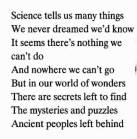

ПРИЛОЖЕНИЕ 5
| STONEHENGE |
| Built in several stages, it began about 5,000 years ago as a simple earthwork enclosure where prehistoric people buried their cremated dead. The stone circle was erected in the centre of the monument in the late Neolithic period, around 2500 BC. There are 83 stones in total. A circle of 56 pits, known as the Aubrey Holes sits inside the enclosure. Its purpose remains unknown. This structure has a long relationship with astronomers. |
| Built in several stages, it began about 5,000 years ago
| as a simple earthwork enclosure where prehistoric people buried their cremated dead. | The stone circle was erected in the centre of the monument |
| in the late Neolithic period, around 2500 BC.
| There are 83 stones in total. A circle of 56 pits,
| known as the Aubrey Holes sits inside the enclosure. Its purpose
|
| remains unknown. | This structure has a | long relationship with astronomers. |
| PYRAMIDS IN GIZA |
| These constructions are of the world's most amazing landmarks. Rising high above the Sahara Desert in the Giza region of northern Egypt, the greatest part of it rises some 450 feet into the burning desert sky and occupies an area of 13 acres. It was such an amazing feat of engineering that it remained the tallest structure in the world for over 3800 years! |
| These constructions are of the world's most amazing landmarks. Rising high above the Sahara Desert in | the Giza region of northern Egypt, the greatest part of it | rises some 450 feet into the burning desert sky and occupies |
| an area of 13 acres. It was such an amazing feat of engineering that it remained the tallest | structure in the world for over 3800 years! It took tens of thousands of workers twenty years | to build. It contains over two million stone blocks. Although most of the blocks weigh two or |
| three tons, some weigh up to 80 tons! It is actually part of | a complex that includes a variety of pyramids | and structures, and the Great Sphinx. |
| TAJ MAHAL | ||
| The history of this beautiful marble architect monument goes back in the golden era of Mughal Empire. There are varied legends associated with construction of it. These myths are not yet proven but surely attract people from all over the world to visit the magnificent sight renowned for varied stories. One of the myths is that the name of the magnificent monument is derived from the Persian language. Thereby the first word of its name - means crown and the second - means palace hence, So it literally means “Crown Palace”. Another myth is based on the common tradition of burying the real graves in the tombs. It is believed that this monument apart from containing the representative grave also contains her real grave inside. One more myth says that Shah Jahan had ordered to chop off the hands of the architects and craftsmen after the completion of the monuments so that they could never build a monument as beautiful as that one ever again. | ||
| The history of this beautiful marble architect monument goes back in the golden era of Mughal Empire. There are varied legends | associated with construction of it. These myths are not yet proven | but surely attract people from all over the world to visit the |
| magnificent sight renowned for varied stories. One of the myths is that the name of the magnificent monument is derived from the Persian | language. Thereby the first word of its name - means crown and the second - means palace hence, So it literally means “Crown | Palace”. Another myth is based on the common tradition of burying the real graves in the tombs. It is believed |
| that this monument apart from containing the representative grave also contains her real grave inside. One more | myth says that Shah Jahan had ordered to chop off the hands | of the architects and craftsmen after the completion of the monuments so that they could never build a monument as beautiful as that one ever again. |
| COLISEUM |
| It is located in the centre of the city of Rome, Italy. When it was first built it was originally called the Flavian Amphitheatre. Its name derives from the word “collossal”. It was built for several reasons: as a gift to Roman Citizens, increasing the popularity of the Flavian dynasty; staging various forms of entertainment; to utilize and showcase the latest Roman engineering techniques demonstrating to the world the power of Rome. It consisted of four floors. The great amphitheatre covers an area of 6 acres. Entrance to the games was free. The massive amphitheatre had a capacity estimated at between 50,000 and 80,000 Romans. There were 36 trap doors in Arena allowing for elaborate special effects. It was used for staging various events including gladiator fights, wild animal displays, theatrical entertainment, executions, religious ceremonies, mock sea battles and re-playing famous Roman victories. There were over 20 different types of Gladiators. The animals displayed and killed at the theatre were transported from every corner of the Roman Empire reflecting the scale and scope of the Roman provinces. The wild and exotic animals included lions, tigers, hyenas, hippos, rhino's, crocodiles, ostriches, antelopes, bears and zebras. |
| It is located in the centre of the city of Rome, Italy. When it was first built it was originally called the Flavian Amphitheatre. Its name derives | from the word “collossal”. It was built for several reasons: as a | gift to Roman Citizens, increasing the popularity of the Flavian dynasty; staging various forms of entertainment; to utilize and showcase the latest Roman |
| engineering techniques demonstrating to the world the power of Rome. It consisted of four floors. The great amphitheatre covers an area | of 6 acres. Entrance to the games was free. The massive amphitheatre had a capacity estimated at between 50,000 and 80,000 Romans. There were 36 | trap doors in Arena allowing for elaborate special effects. It was used for staging various events including gladiator fights, wild animal displays, theatrical entertainment, |
| executions, religious ceremonies, mock sea battles and re-playing famous Roman victories. There were over 20 different types of Gladiators. The animals displayed and killed at the theatre were | transported from every corner of the Roman Empire reflecting the scale and scope of the Roman provinces. The wild and exotic animals included | lions, tigers, hyenas, hippos, rhino's, crocodiles, ostriches, antelopes, bears and zebras. |
| THE GREAT WALL OF CHINA |
| It is about 2,700 years old. |
| It is about 2,700 years old. | of human engineering. | Mongolia and north China. The structure is not a single line! It is a defensive network consisting of many |
| walls and forts built in different historical periods. In some places, it doubles or | even triples itself. It attracts 50 million visitors every year, and had been visited by more | than 460 state heads and VIPs from around |
| the world. In early 19th century, it had once given rise to a rumor that it could be seen from the moon with naked eyes. In fact, it is invisible from | the space. Difficulty in observing this object with unaided eyes from space equals that of seeing a hair from two miles away! | in the world. Traversing northern part of the country, what was a huge military line of defense in the past has now become a unique world heritage site and a symbol of China. |
ПРИЛОЖЕНИЕ 6
|
|
|
|
|
|
|
|
|
|

 Получите свидетельство
Получите свидетельство Вход
Вход

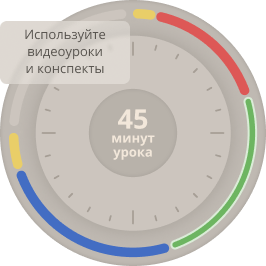

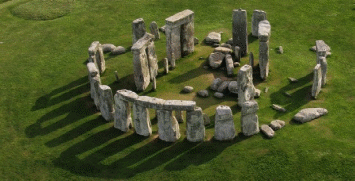

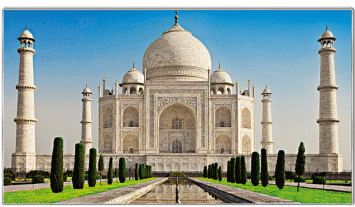
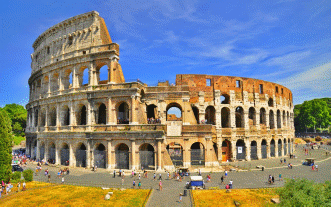

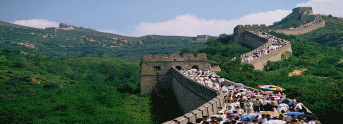









 Методическая разработка урока по учебной дисциплине "Иностранный язык" на тему: "Путешествия. Чудеса и загадки" (2.78 MB)
Методическая разработка урока по учебной дисциплине "Иностранный язык" на тему: "Путешествия. Чудеса и загадки" (2.78 MB)
 0
0 215
215 1
1 Нравится
0
Нравится
0


